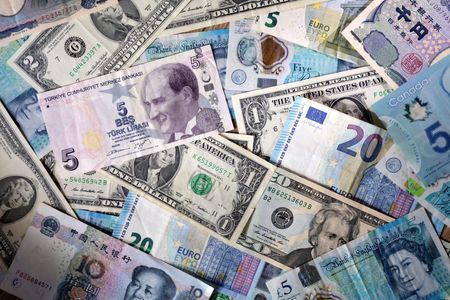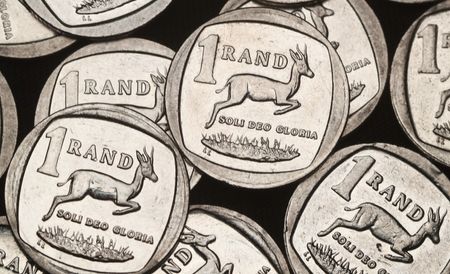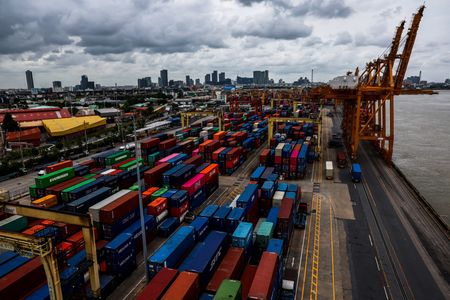By Rae Wee and Lucy Raitano
SINGAPORE/LONDON (Reuters) -The euro briefly hit a three-week low on Monday before partially recovering, while the dollar held steady in a muted reaction to U.S. President Donald Trump’s threat to impose a 30% tariff on imports from two of the largest U.S. trading partners from August 1.
Analysts pointed to the so-called TACO (“Trump always chickens out”) trade as keeping a cap on any bigger moves in forex markets, as well as the fact that traders were more focused on U.S. CPI figures due on Tuesday for a view on the dollar.
“Markets are really not willing to play the ups and downs of Trump’s communication on tariffs,” said Francesco Pesole, FX strategist at ING.
“If you know in 24 hours you will get a release that could completely change the pricing on the Fed, and have a bigger impact on the dollar, I can understand being extra cautious,” said Pesole.
“You know the tariffs story can inflate one day and deflate the next. Hard data – you need to wait another month.”
More significant moves were seen in cryptocurrencies, with bitcoin scaling a record high and surpassing the $120,000 mark.
Later in the day, the U.S. House of Representatives was due to debate a series of bills to provide the digital asset industry with the national regulatory framework it has long demanded.
The world’s largest cryptocurrency last traded 1.8% higher at $121,375.73, while ether gained 2.2% to $3,059.89.
Trump on Saturday announced the latest tariffs in separate letters to European Commission President Ursula von der Leyen and Mexican President Claudia Sheinbaum that were posted on his Truth Social media site.
Both the European Union and Mexico described the tariffs as unfair and disruptive, while the EU said it would extend its suspension of countermeasures to U.S. tariffs until early August and continue to press for a negotiated settlement.
The EU, along with South Korea, also said on Monday they were working on trade deals with Trump that would soften the blow from looming tariffs.
“If Trump actually manages to extract significant concessions from U.S. trading partners by threatening them with tariffs, this could be seen as positive for the dollar. This is especially true if the concessions involve trading partners lowering their tariffs on U.S. products,” wrote Commerzbank analysts in a morning note.
However, they also flagged a potential downside to the dollar from the high uncertainty facing U.S. companies as they face possible tariffs at any time, and the impact on their willingness to invest.
Investors have grown increasingly desensitised to Trump’s slew of tariff threats, with his latest upheaval in the global trade landscape doing little to prevent U.S. stocks from scaling record highs and offering just a slight boost to the dollar.
The euro did slip to a roughly three-week low early in the session, but later regained some ground and was last flat at $1.16905.
Elsewhere, sterling was flat at $1.34855, while the Japanese yen rose marginally to 147.27 per dollar.
Against the Mexican peso, the dollar rose 0.3% to 18.686.
In other currencies, the Australian dollar fell 0.11% to $0.65675, while the New Zealand dollar slid 0.29% to $0.59910.
U.S. inflation figures for June will hit screens on Tuesday, with a Reuters poll finding consensus expectations for a 0.3% rise in core CPI.
It comes ahead of the Fed’s policy meeting later in July with markets currently pricing in just over 50 basis points worth of Fed easing by December.
“After two [CPI reads] of 0.1% in April and May, do tariffs percolate to CPI goods?” said Kenneth Broux, head of corporate research FX and rates at Societe Generale, highlighting a particular area of focus for markets ahead of the data release.
Over at BNP Paribas, market analysts think visible tariff pass-through over the summer and associated risks will keep the Fed on hold through year-end.
Outside of tariff news, Trump on Sunday said that it would be a “great thing” if Fed Jerome Powell stepped down, again threatening to undermine the central bank’s independence as he called for interest rates to be lowered.
In Asia, data on Monday showed China’s exports regained momentum in June while imports rebounded, as exporters rushed out shipments to capitalise on a fragile tariff truce between Beijing and Washington ahead Trump’s August deal deadline.
(Reporting by Rae Wee; Editing by Ros Russell and Sharon Singleton)










